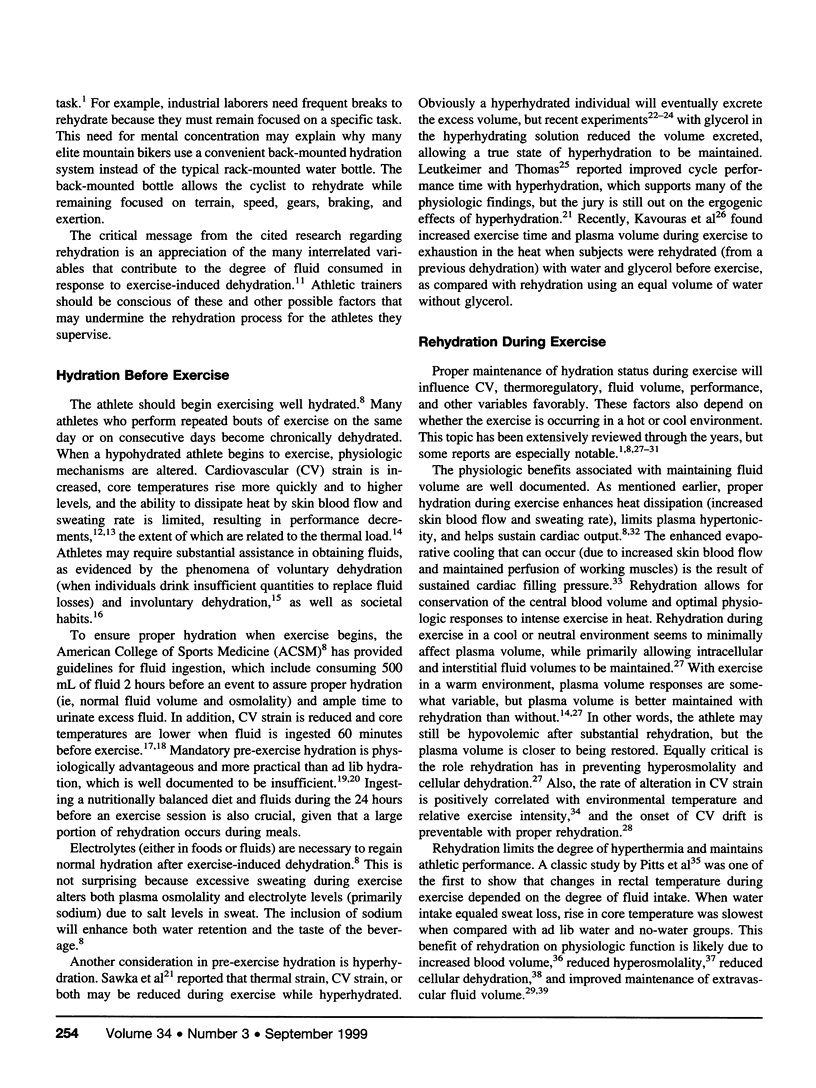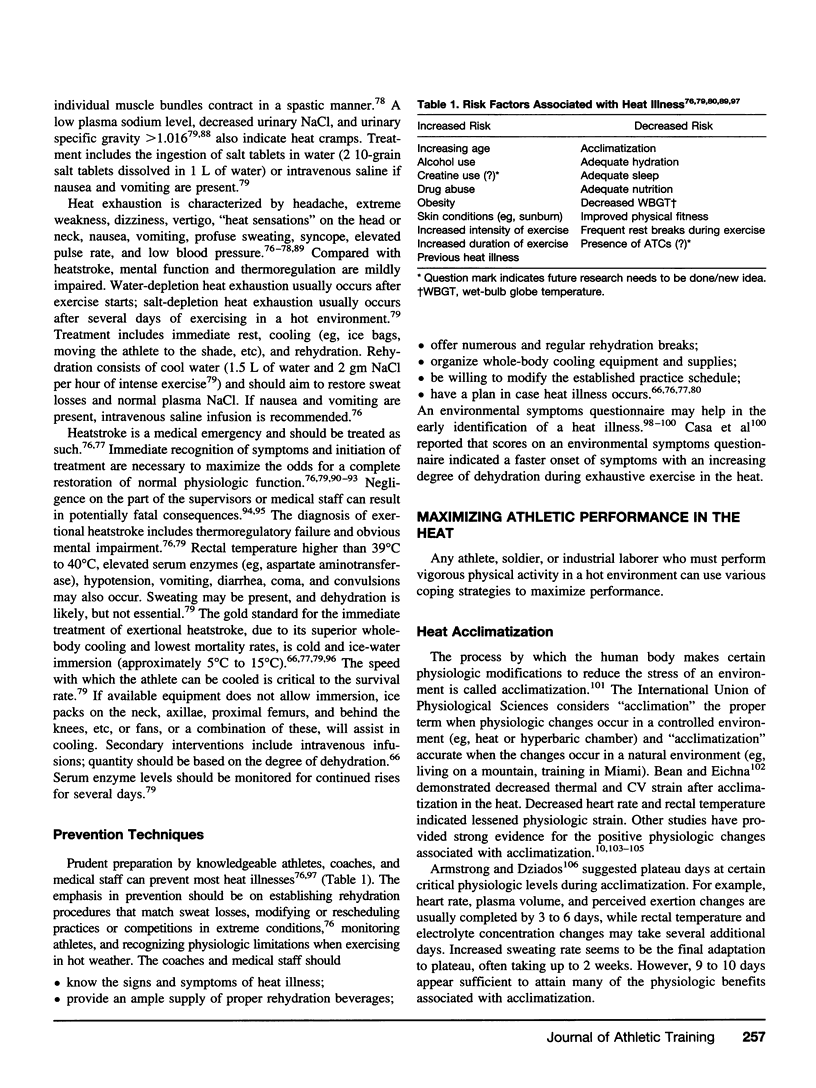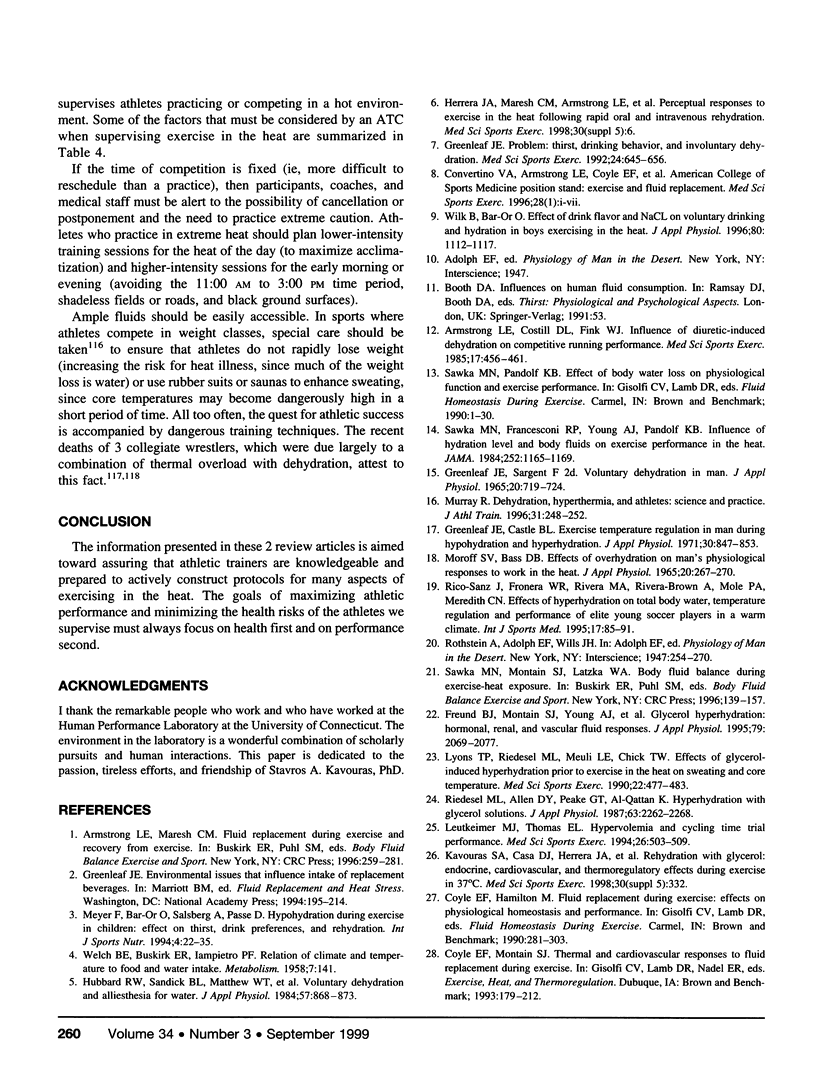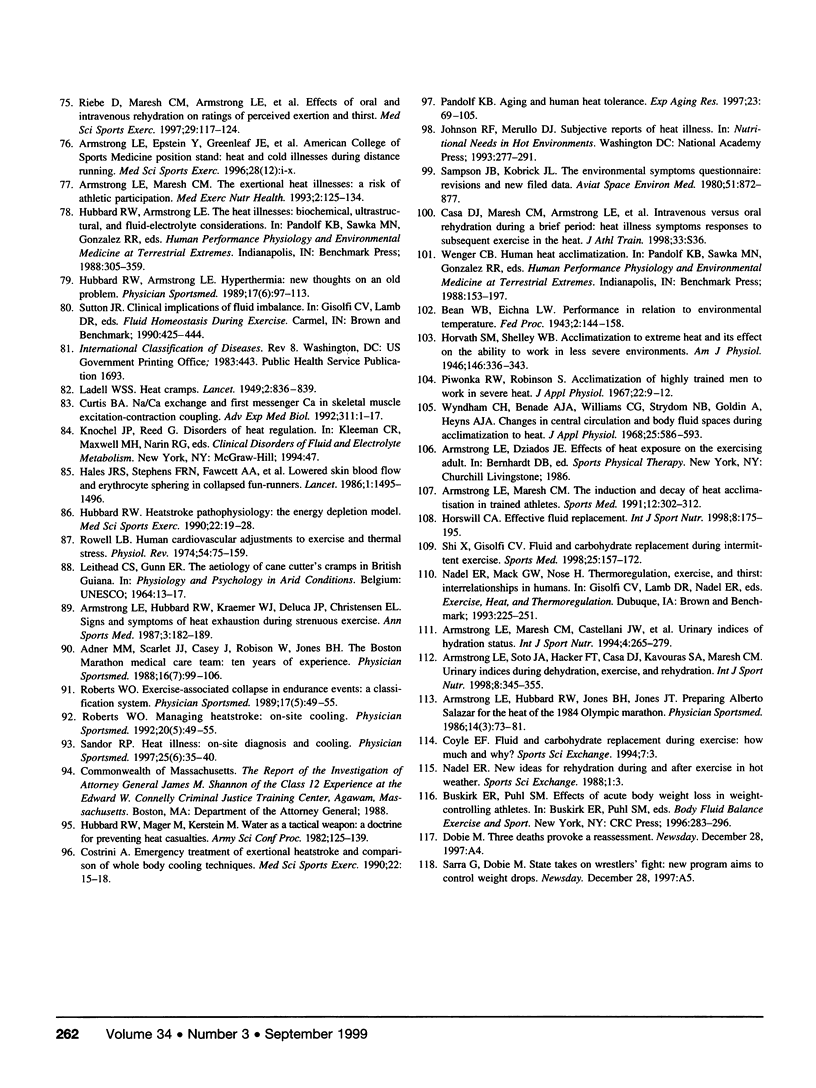Abstract
Objective:
To acquaint athletic trainers with the numerous interrelated components that must be considered when assisting athletes who exercise in hot environments. Useful guidelines to maximize performance and minimize detrimental health consequences are presented.
Data Sources:
The databases MEDLINE and SPORT Discus were searched from 1980 to 1999, with the terms. “body cooling,” “dehydration,” “exercise,” “heat illnesses,” “heat,” “fluid replacement,” “acclimatization,” “hydration,” “rehydration,” “performance,” and “intravenous,” among others.
Data Synthesis:
This paper provides an in-depth look at issues regarding physiologic and performance considerations related to rehydration, strategies to maximize rehydration, modes of rehydration, health consequences of exercise in the heat, heat acclimatization, body cooling techniques, and practice and competition modifications.
Conclusions/Recommendations:
Athletic trainers have a responsibility to ensure that athletes who exercise in hot environments are prepared to do so in an optimal manner and to act properly to avoid the potentially harmful heat illnesses that can result from exercise in the heat.
Keywords: body cooling, dehydration, heat acclimatization, hydration, intravenous
Full text
PDF









Selected References
These references are in PubMed. This may not be the complete list of references from this article.
- Armstrong L. E., Costill D. L., Fink W. J. Influence of diuretic-induced dehydration on competitive running performance. Med Sci Sports Exerc. 1985 Aug;17(4):456–461. doi: 10.1249/00005768-198508000-00009. [DOI] [PubMed] [Google Scholar]
- Armstrong L. E., Maresh C. M., Castellani J. W., Bergeron M. F., Kenefick R. W., LaGasse K. E., Riebe D. Urinary indices of hydration status. Int J Sport Nutr. 1994 Sep;4(3):265–279. doi: 10.1123/ijsn.4.3.265. [DOI] [PubMed] [Google Scholar]
- Armstrong L. E., Maresh C. M. The induction and decay of heat acclimatisation in trained athletes. Sports Med. 1991 Nov;12(5):302–312. doi: 10.2165/00007256-199112050-00003. [DOI] [PubMed] [Google Scholar]
- Armstrong L. E., Soto J. A., Hacker F. T., Jr, Casa D. J., Kavouras S. A., Maresh C. M. Urinary indices during dehydration, exercise, and rehydration. Int J Sport Nutr. 1998 Dec;8(4):345–355. doi: 10.1123/ijsn.8.4.345. [DOI] [PubMed] [Google Scholar]
- Below P. R., Mora-Rodríguez R., González-Alonso J., Coyle E. F. Fluid and carbohydrate ingestion independently improve performance during 1 h of intense exercise. Med Sci Sports Exerc. 1995 Feb;27(2):200–210. [PubMed] [Google Scholar]
- Broad E. M., Burke L. M., Cox G. R., Heeley P., Riley M. Body weight changes and voluntary fluid intakes during training and competition sessions in team sports. Int J Sport Nutr. 1996 Sep;6(3):307–320. doi: 10.1123/ijsn.6.3.307. [DOI] [PubMed] [Google Scholar]
- Convertino V. A., Armstrong L. E., Coyle E. F., Mack G. W., Sawka M. N., Senay L. C., Jr, Sherman W. M. American College of Sports Medicine position stand. Exercise and fluid replacement. Med Sci Sports Exerc. 1996 Jan;28(1):i–vii. doi: 10.1097/00005768-199610000-00045. [DOI] [PubMed] [Google Scholar]
- Costill D. L., Saltin B. Factors limiting gastric emptying during rest and exercise. J Appl Physiol. 1974 Nov;37(5):679–683. doi: 10.1152/jappl.1974.37.5.679. [DOI] [PubMed] [Google Scholar]
- Costill D. L., Sparks K. E. Rapid fluid replacement following thermal dehydration. J Appl Physiol. 1973 Mar;34(3):299–303. doi: 10.1152/jappl.1973.34.3.299. [DOI] [PubMed] [Google Scholar]
- Costrini A. Emergency treatment of exertional heatstroke and comparison of whole body cooling techniques. Med Sci Sports Exerc. 1990 Feb;22(1):15–18. [PubMed] [Google Scholar]
- Cox S. M., MacDonald P. C., Casey M. L. Assay of bacterial endotoxin (lipopolysaccharide) in human amniotic fluid: potential usefulness in diagnosis and management of preterm labor. Am J Obstet Gynecol. 1988 Jul;159(1):99–106. doi: 10.1016/0002-9378(88)90501-7. [DOI] [PubMed] [Google Scholar]
- Curtis B. A. Na/Ca exchange and first messenger Ca in skeletal muscle excitation-contraction coupling. Adv Exp Med Biol. 1992;311:1–17. doi: 10.1007/978-1-4615-3362-7_1. [DOI] [PubMed] [Google Scholar]
- Davis J. M., Jackson D. A., Broadwell M. S., Queary J. L., Lambert C. L. Carbohydrate drinks delay fatigue during intermittent, high-intensity cycling in active men and women. Int J Sport Nutr. 1997 Dec;7(4):261–273. doi: 10.1123/ijsn.7.4.261. [DOI] [PubMed] [Google Scholar]
- Davis J. M., Lamb D. R., Pate R. R., Slentz C. A., Burgess W. A., Bartoli W. P. Carbohydrate-electrolyte drinks: effects on endurance cycling in the heat. Am J Clin Nutr. 1988 Oct;48(4):1023–1030. doi: 10.1093/ajcn/48.4.1023. [DOI] [PubMed] [Google Scholar]
- Deschamps A., Levy R. D., Cosio M. G., Marliss E. B., Magder S. Effect of saline infusion on body temperature and endurance during heavy exercise. J Appl Physiol (1985) 1989 Jun;66(6):2799–2804. doi: 10.1152/jappl.1989.66.6.2799. [DOI] [PubMed] [Google Scholar]
- Fallowfield J. L., Williams C. Carbohydrate intake and recovery from prolonged exercise. Int J Sport Nutr. 1993 Jun;3(2):150–164. doi: 10.1123/ijsn.3.2.150. [DOI] [PubMed] [Google Scholar]
- Fortney S. M., Wenger C. B., Bove J. R., Nadel E. R. Effect of blood volume on forearm venous and cardiac stroke volume during exercise. J Appl Physiol Respir Environ Exerc Physiol. 1983 Sep;55(3):884–890. doi: 10.1152/jappl.1983.55.3.884. [DOI] [PubMed] [Google Scholar]
- Freund B. J., Montain S. J., Young A. J., Sawka M. N., DeLuca J. P., Pandolf K. B., Valeri C. R. Glycerol hyperhydration: hormonal, renal, and vascular fluid responses. J Appl Physiol (1985) 1995 Dec;79(6):2069–2077. doi: 10.1152/jappl.1995.79.6.2069. [DOI] [PubMed] [Google Scholar]
- González-Alonso J., Heaps C. L., Coyle E. F. Rehydration after exercise with common beverages and water. Int J Sports Med. 1992 Jul;13(5):399–406. doi: 10.1055/s-2007-1021288. [DOI] [PubMed] [Google Scholar]
- Greenleaf J. E., Castle B. L. Exercise temperature regulation in man during hypohydration and hyperhydration. J Appl Physiol. 1971 Jun;30(6):847–853. doi: 10.1152/jappl.1971.30.6.847. [DOI] [PubMed] [Google Scholar]
- Greenleaf J. E., Kolzowski S., Nazar K., Kaciuba-Uściłko H., Brzezińska Z., Ziemba A. Ion-osmotic hyperthermia during exercise in dogs. Am J Physiol. 1976 Jan;230(1):74–79. doi: 10.1152/ajplegacy.1976.230.1.74. [DOI] [PubMed] [Google Scholar]
- Greenleaf J. E. Problem: thirst, drinking behavior, and involuntary dehydration. Med Sci Sports Exerc. 1992 Jun;24(6):645–656. [PubMed] [Google Scholar]
- Greenleaf J. E., Sargent F., 2nd Voluntary dehydration in man. J Appl Physiol. 1965 Jul;20(4):719–724. doi: 10.1152/jappl.1965.20.4.719. [DOI] [PubMed] [Google Scholar]
- Hales J. R., Stephens F. R., Fawcett A. A., Westerman R. A., Vaughan J. D., Richards D. A., Richards C. R. Lowered skin blood flow and erythrocyte sphering in collapsed fun-runners. Lancet. 1986 Jun 28;1(8496):1495–1496. doi: 10.1016/s0140-6736(86)91526-6. [DOI] [PubMed] [Google Scholar]
- Hamilton M. T., Gonzalez-Alonso J., Montain S. J., Coyle E. F. Fluid replacement and glucose infusion during exercise prevent cardiovascular drift. J Appl Physiol (1985) 1991 Sep;71(3):871–877. doi: 10.1152/jappl.1991.71.3.871. [DOI] [PubMed] [Google Scholar]
- Horswill C. A. Effective fluid replacement. Int J Sport Nutr. 1998 Jun;8(2):175–195. doi: 10.1123/ijsn.8.2.175. [DOI] [PubMed] [Google Scholar]
- Hubbard R. W. Heatstroke pathophysiology: the energy depletion model. Med Sci Sports Exerc. 1990 Feb;22(1):19–28. [PubMed] [Google Scholar]
- Hubbard R. W., Sandick B. L., Matthew W. T., Francesconi R. P., Sampson J. B., Durkot M. J., Maller O., Engell D. B. Voluntary dehydration and alliesthesia for water. J Appl Physiol Respir Environ Exerc Physiol. 1984 Sep;57(3):868–873. doi: 10.1152/jappl.1984.57.3.868. [DOI] [PubMed] [Google Scholar]
- Lambert G. P., Chang R. T., Joensen D., Shi X., Summers R. W., Schedl H. P., Gisolfi C. V. Simultaneous determination of gastric emptying and intestinal absorption during cycle exercise in humans. Int J Sports Med. 1996 Jan;17(1):48–55. doi: 10.1055/s-2007-972807. [DOI] [PubMed] [Google Scholar]
- Luetkemeier M. J., Thomas E. L. Hypervolemia and cycling time trial performance. Med Sci Sports Exerc. 1994 Apr;26(4):503–509. [PubMed] [Google Scholar]
- Lyons T. P., Riedesel M. L., Meuli L. E., Chick T. W. Effects of glycerol-induced hyperhydration prior to exercise in the heat on sweating and core temperature. Med Sci Sports Exerc. 1990 Aug;22(4):477–483. [PubMed] [Google Scholar]
- Maughan R. J., Noakes T. D. Fluid replacement and exercise stress. A brief review of studies on fluid replacement and some guidelines for the athlete. Sports Med. 1991 Jul;12(1):16–31. doi: 10.2165/00007256-199112010-00003. [DOI] [PubMed] [Google Scholar]
- Meyer F., Bar-Or O., Salsberg A., Passe D. Hypohydration during exercise in children: effect on thirst, drink preferences, and rehydration. Int J Sport Nutr. 1994 Mar;4(1):22–35. doi: 10.1123/ijsn.4.1.22. [DOI] [PubMed] [Google Scholar]
- Millard-Stafford M. Fluid replacement during exercise in the heat. Review and recommendations. Sports Med. 1992 Apr;13(4):223–233. doi: 10.2165/00007256-199213040-00001. [DOI] [PubMed] [Google Scholar]
- Mitchell J. B., Grandjean P. W., Pizza F. X., Starling R. D., Holtz R. W. The effect of volume ingested on rehydration and gastric emptying following exercise-induced dehydration. Med Sci Sports Exerc. 1994 Sep;26(9):1135–1143. [PubMed] [Google Scholar]
- Montain S. J., Coyle E. F. Fluid ingestion during exercise increases skin blood flow independent of increases in blood volume. J Appl Physiol (1985) 1992 Sep;73(3):903–910. doi: 10.1152/jappl.1992.73.3.903. [DOI] [PubMed] [Google Scholar]
- Montain S. J., Coyle E. F. Influence of graded dehydration on hyperthermia and cardiovascular drift during exercise. J Appl Physiol (1985) 1992 Oct;73(4):1340–1350. doi: 10.1152/jappl.1992.73.4.1340. [DOI] [PubMed] [Google Scholar]
- Murray R., Bartoli W. P., Eddy D. E., Horn M. K. Gastric emptying and plasma deuterium accumulation following ingestion of water and two carbohydrate-electrolyte beverages. Int J Sport Nutr. 1997 Jun;7(2):144–153. doi: 10.1123/ijsn.7.2.144. [DOI] [PubMed] [Google Scholar]
- Murray R. Dehydration, hyperthermia, and athletes: science and practice. J Athl Train. 1996 Jul;31(3):248–252. [PMC free article] [PubMed] [Google Scholar]
- Murray R., Eddy D. E., Murray T. W., Seifert J. G., Paul G. L., Halaby G. A. The effect of fluid and carbohydrate feedings during intermittent cycling exercise. Med Sci Sports Exerc. 1987 Dec;19(6):597–604. [PubMed] [Google Scholar]
- Murray R. The effects of consuming carbohydrate-electrolyte beverages on gastric emptying and fluid absorption during and following exercise. Sports Med. 1987 Sep-Oct;4(5):322–351. doi: 10.2165/00007256-198704050-00002. [DOI] [PubMed] [Google Scholar]
- Neufer P. D., Young A. J., Sawka M. N. Gastric emptying during exercise: effects of heat stress and hypohydration. Eur J Appl Physiol Occup Physiol. 1989;58(4):433–439. doi: 10.1007/BF00643521. [DOI] [PubMed] [Google Scholar]
- Neufer P. D., Young A. J., Sawka M. N. Gastric emptying during walking and running: effects of varied exercise intensity. Eur J Appl Physiol Occup Physiol. 1989;58(4):440–445. doi: 10.1007/BF00643522. [DOI] [PubMed] [Google Scholar]
- Noakes T. D., Rehrer N. J., Maughan R. J. The importance of volume in regulating gastric emptying. Med Sci Sports Exerc. 1991 Mar;23(3):307–313. [PubMed] [Google Scholar]
- Nose H., Mack G. W., Shi X. R., Morimoto K., Nadel E. R. Effect of saline infusion during exercise on thermal and circulatory regulations. J Appl Physiol (1985) 1990 Aug;69(2):609–616. doi: 10.1152/jappl.1990.69.2.609. [DOI] [PubMed] [Google Scholar]
- Nose H., Mack G. W., Shi X. R., Nadel E. R. Role of osmolality and plasma volume during rehydration in humans. J Appl Physiol (1985) 1988 Jul;65(1):325–331. doi: 10.1152/jappl.1988.65.1.325. [DOI] [PubMed] [Google Scholar]
- Pandolf K. B. Aging and human heat tolerance. Exp Aging Res. 1997 Jan-Mar;23(1):69–105. doi: 10.1080/03610739708254027. [DOI] [PubMed] [Google Scholar]
- Piwonka R. W., Robinson S. Acclimatization of highly trained men to work in severe heat. J Appl Physiol. 1967 Jan;22(1):9–12. doi: 10.1152/jappl.1967.22.1.9. [DOI] [PubMed] [Google Scholar]
- Rico-Sanz J., Frontera W. R., Rivera M. A., Rivera-Brown A., Mole P. A., Meredith C. N. Effects of hyperhydration on total body water, temperature regulation and performance of elite young soccer players in a warm climate. Int J Sports Med. 1996 Feb;17(2):85–91. doi: 10.1055/s-2007-972813. [DOI] [PubMed] [Google Scholar]
- Riebe D., Maresh C. M., Armstrong L. E., Kenefick R. W., Castellani J. W., Echegaray M. E., Clark B. A., Camaione D. N. Effects of oral and intravenous rehydration on ratings of perceived exertion and thirst. Med Sci Sports Exerc. 1997 Jan;29(1):117–124. doi: 10.1097/00005768-199701000-00017. [DOI] [PubMed] [Google Scholar]
- Riedesel M. L., Allen D. Y., Peake G. T., Al-Qattan K. Hyperhydration with glycerol solutions. J Appl Physiol (1985) 1987 Dec;63(6):2262–2268. doi: 10.1152/jappl.1987.63.6.2262. [DOI] [PubMed] [Google Scholar]
- Rowell L. B. Human cardiovascular adjustments to exercise and thermal stress. Physiol Rev. 1974 Jan;54(1):75–159. doi: 10.1152/physrev.1974.54.1.75. [DOI] [PubMed] [Google Scholar]
- Rowell L. B., Marx H. J., Bruce R. A., Conn R. D., Kusumi F. Reductions in cardiac output, central blood volume, and stroke volume with thermal stress in normal men during exercise. J Clin Invest. 1966 Nov;45(11):1801–1816. doi: 10.1172/JCI105484. [DOI] [PMC free article] [PubMed] [Google Scholar]
- Sampson J. B., Kobrick J. L. The environmental symptoms questionnaire: revisions and new filed data. Aviat Space Environ Med. 1980 Sep;51(9 Pt 1):872–877. [PubMed] [Google Scholar]
- Sawka M. N., Francesconi R. P., Young A. J., Pandolf K. B. Influence of hydration level and body fluids on exercise performance in the heat. JAMA. 1984 Sep 7;252(9):1165–1169. [PubMed] [Google Scholar]
- Shi X., Gisolfi C. V. Fluid and carbohydrate replacement during intermittent exercise. Sports Med. 1998 Mar;25(3):157–172. doi: 10.2165/00007256-199825030-00003. [DOI] [PubMed] [Google Scholar]
- Shirreffs S. M., Taylor A. J., Leiper J. B., Maughan R. J. Post-exercise rehydration in man: effects of volume consumed and drink sodium content. Med Sci Sports Exerc. 1996 Oct;28(10):1260–1271. doi: 10.1097/00005768-199610000-00009. [DOI] [PubMed] [Google Scholar]
- WELCH B. E., BUSKIRK E. R., IAMPIETRO P. F. Relation of climate and temperature to food and water intake in man. Metabolism. 1958 Mar;7(2):141–148. [PubMed] [Google Scholar]
- Wemple R. D., Morocco T. S., Mack G. W. Influence of sodium replacement on fluid ingestion following exercise-induced dehydration. Int J Sport Nutr. 1997 Jun;7(2):104–116. doi: 10.1123/ijsn.7.2.104. [DOI] [PubMed] [Google Scholar]
- Wilk B., Bar-Or O. Effect of drink flavor and NaCL on voluntary drinking and hydration in boys exercising in the heat. J Appl Physiol (1985) 1996 Apr;80(4):1112–1117. doi: 10.1152/jappl.1996.80.4.1112. [DOI] [PubMed] [Google Scholar]
- Wyndham C. H., Benade A. J., Williams C. G., Strydom N. B., Goldin A., Heyns A. J. Changes in central circulation and body fluid spaces during acclimatization to heat. J Appl Physiol. 1968 Nov;25(5):586–593. doi: 10.1152/jappl.1968.25.5.586. [DOI] [PubMed] [Google Scholar]


